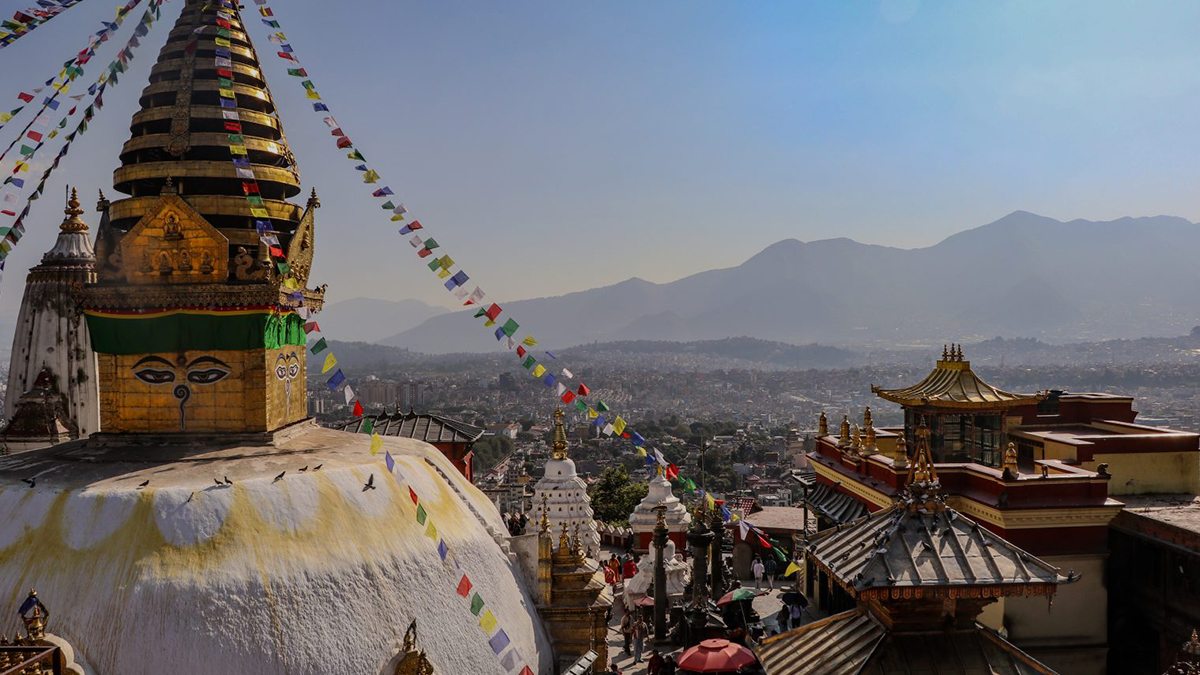Tar Heel team begins preservation of ancient Nepal temple
Religious studies scholar and computer scientist want to create 3D model of 1,500-year-old Buddhist shrine.

In a groundbreaking initiative, a team from Carolina’s College of Arts and Sciences traveled to Nepal in October to begin the digital preservation of one of the country’s most venerable religious shrines. The 1,500-year-old Swayambhu Temple, a jewel of Buddhist heritage perched atop a hill in the Kathmandu Valley, is one of 10 UNESCO World Heritage sites in Nepal.
Lauren Leve, an associate professor of religious studies, and Jim Mahaney, a research scientist in the computer science department, started the long process of capturing the data needed to create an accurate 3D model of the entire temple complex. One of the project’s goals is to allow UNC-Chapel Hill students a chance to visit Swayambhu in virtual reality.
The project leverages the distinct skill sets of Leve and Mahaney to both access and capture this sacred site. Leve and Mahaney are using a three-pronged data capture approach, combining 3D laser scans, photogrammetry and drone photography to create three separate models of the temple complex. The three models will then be combined to form one photorealistic model of the temple complex which will be viewable on multiple device types, so that access to the model is not limited by the technology available in different parts of the world.
Crowds, monkeys and lots of data
One challenge of capturing Swayambhu was working around crowds of people and animals. Typically, a historic site would be closed to allow for scanning and photogrammetry, but as an active temple, Swayambhu could not be closed and is visited by worshippers and tourists nearly 24 hours a day.
While the humans could be reasoned with, a local population of more than 400 rhesus macaque monkeys also has free range over the entire site. The monkeys refused to take direction from the team, often flaunting their independence by climbing about in the background of the scans. This interference will require hours of additional post-processing to remove monkeys from the 3D model.
Because of the task’s immense scale, Leve and Mahaney partnered with a local heritage preservation group, Baakhan Nyane waa (which translates from the Newar or Nepal Bhasa language as “Come, listen to stories”), and the Kathmandu Engineering College. Raj Maharjan from Baakhan Nyane waa worked with Mahaney to teach graduate students from the college in a seven-day course on laser scanning and photogrammetry, which included many hours of hands-on fieldwork at Swayambhu.
During the course, the team completed 92 scans and took thousands of photos from the ground and hundreds from the sky. The work of combining these into a 3D model will take many months and will provide opportunities for UNC-Chapel Hill computer science students to work with this dataset not only on editing process but also to explore various advanced techniques in virtual reality, such as redirected walking.
Students in Nepal will also continue to work with the data, making this an international collaboration that not only works to create an outstanding model of the site but considers the subtle nuances of how the site is viewed by the Nepalese.
While the amount of data collected on this first trip is vast, additional visits to Nepal are necessary to capture the entire temple. In a planned trip in October 2024, the team will begin expanding the model to include more of the structures located adjacent to the main temple.
This work is supported by a CFE/Lenovo Instructional Innovation grant with additional hardware support from Nvidia and the School of Data Science and Society.
Read more about this trip and the precursor to it.







